have a table that i would like it to select the smallest size picture frame that could be used based on the size values, basically return the smallest frame that would fit the image.
For example i have 4 standard sizes:
a b c
Size1 150 150
Size2 300 300
Size3 540 570
Size4 800 800
I want to have a size in another cell e.g. 290 x 300 and would like it to pick the smallest size possible to fit i.e. in this case size2.
I've followed a few guides and have the following that will print out the value if the values are exact but not if they are slightly under one of the options
=VLOOKUP($A$8,CHOOSE({1,2},$B$2:$B$5&", "&$A$2:$A$5,$C$2:$C$5),2,0)
Any helo / direction would be much appreactiated!
Thanks

